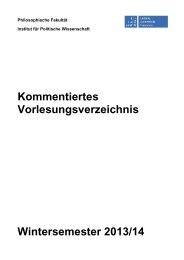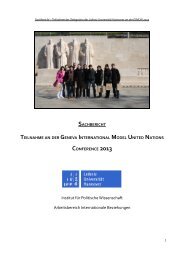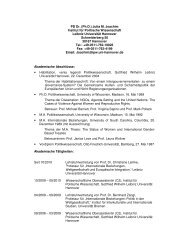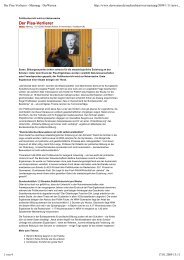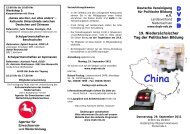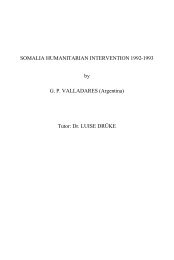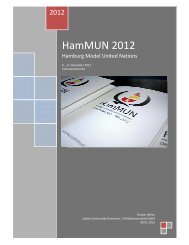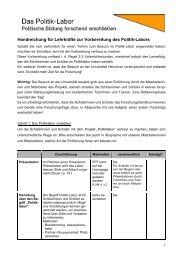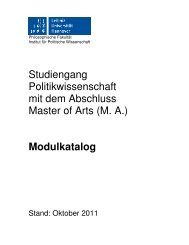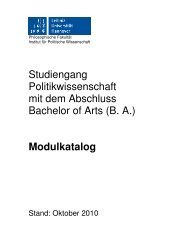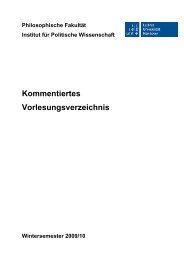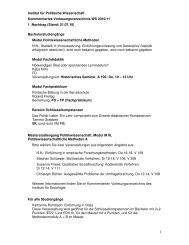Preventive Action for Refugee Producing Situations
Preventive Action for Refugee Producing Situations
Preventive Action for Refugee Producing Situations
You also want an ePaper? Increase the reach of your titles
YUMPU automatically turns print PDFs into web optimized ePapers that Google loves.
34 Chapter 1 Introduction 35<br />
abroad <strong>for</strong> those found refugees and return to Vietnam <strong>for</strong> those not<br />
qualifying <strong>for</strong> refugee status. To describe the complete Plan would require a<br />
full new chapter which will be available elsewhere. Here this development<br />
is only mentioned <strong>for</strong> the record and to show that it was finally<br />
political/humanitarian action, which lead to the situation that in 1992 there<br />
have been practically no new arrivals from Vietnam.<br />
The second group of examples in this chapter will discuss two<br />
instances in which, at the cost of much human misery, no specific<br />
preventive actions were taken. The United Nations, in coordination with<br />
interested governments and perhaps with competent nongovernmental<br />
agencies, could probably have taken steps to alleviate, if not prevent, the<br />
serious repercussions on the victims of these tragic situations.<br />
The Nicaraguan refugees in Honduras and the International Conference<br />
on <strong>Refugee</strong>s in Central America (CIREFCA)<br />
Between the beginning of 1982 and 1986, Nicaraguans of Miskito, Sumo,<br />
and Rama ethnic origin crossed into Honduras from the Atlantic Coast of<br />
Nicaragua, many of them involuntarily. 38 The problem of "induced asylum"<br />
has continued over the years to varying degrees, but became particularly<br />
acute in early 1986 with a new wave of about 8,500 "refugees," the largest<br />
group ever to cross the border.<br />
Despite the available evidence about this incipient movement obtained<br />
in interviews with Miskito Indians who had just arrived in the refugee<br />
locations, no specific action was taken on the conditions that were <strong>for</strong>cing<br />
people to move.<br />
___________________<br />
38 The U.S.-based human rights organization Americas Watch undertook a<br />
field study in early 1986 to establish the facts behind the movements of<br />
Nicaraguan Miskito Indians into Honduras. Upon rumors that KISAN (the<br />
and Sandinista indigenous armed <strong>for</strong>ces operating in the Mosquitia) planned<br />
to "move all people living on the Nicaraguan side of the Rio Coco into<br />
Honduras," Americas Watch interviewed the first vanguard of entering<br />
Miskito Indians in early April and found that everyone was going to leave<br />
the Rio Coco: "Every last one ("toditos") they said, no one will be left."<br />
Americas Watch also confirmed that the Miskito Indians wanted to stay in<br />
their homes in Nicaragua and would not move lightly, but believed that they<br />
were pressured into doing so by KISAN because the "U.S. Congress, which<br />
was to vote on contra aid in the spring of 1986, would consider very<br />
seriously the flight of a large number of Miskito refugees." See "Americas<br />
Watch Committee. With the Miskitos in Honduras, (New York and<br />
Washington, D.C.: Americas Watch Committee, 11 April 2986), pp. 13-14.<br />
The purpose of this study is to show that <strong>for</strong> more than five years, and<br />
most clearly in early 1986 with the last large movement, people were<br />
uprooted time and again often against their will and often without<br />
knowing the real reason <strong>for</strong> crossing the border into Honduras. Since<br />
completing this book, the CIREFCA took place in 1989 which mobilized<br />
political and material support <strong>for</strong> many refugees to be able to return home<br />
in peace. All Nicaraguan refugees are now home and the UNHCR Office<br />
in Honduras is almost closed.<br />
Vietnam Be<strong>for</strong>e 1975<br />
Alarmed by the escalation of American involvement in Vietnam from the<br />
early 1960s, U.S. Senator Edward Kennedy undertook a personal initiative<br />
in 1966 to obtain humanitarian assistance on behalf of refugees and<br />
displaced persons within Vietnam from the United Nations and its<br />
specialized agencies, which were great untapped sources of assistance<br />
with trained personnel experienced in humanitarian activities." 39<br />
Un<strong>for</strong>tunately, his contacts with the Secretary-General and other heads of<br />
agencies, including the UN High Commissioner <strong>for</strong> <strong>Refugee</strong>s, failed to<br />
produce concrete results.<br />
Disregarding the overwhelming strain placed on Vietnamese and U.S.<br />
assistance mechanisms by massive waves of internal refugees <strong>for</strong>cibly<br />
relocated, uprooted, and displaced, the U.S. Armed Forces Commanders<br />
went on generating refugees regardless of what would become of them. 40<br />
The International community had reason to be concerned about the fate of<br />
the many millions of innocent Vietnamese civilians who became victims<br />
of policies that have long since been condemned.<br />
Chapter 4 has been rewritten. It is the heart of the thesis. This Chapter<br />
is intended to show that only in the last four years, since the completing of<br />
the first edition, revolutionary changes have contributed to new<br />
approaches and policies <strong>for</strong> refugee prevention.<br />
The first part on the UN Conflict Prevention documents <strong>for</strong>ty years<br />
of experience much of which has indirectly had an impact on the<br />
39 U.S. Senate. A Report to the Committee on the Judiciary. <strong>Refugee</strong><br />
Problem in South Vietnam. Subcommittee to Investigate Problems<br />
connected with <strong>Refugee</strong>s and Escapees. 89th Cong., 2nd sess., March<br />
4,1966, p. 11-14.<br />
40 Louis Wiesner, Victims and Survivors, Displaced Persons and Other<br />
War Victims in Vietnam, 1954-1975, (New York: Greenwood Press,<br />
1988), in press.



